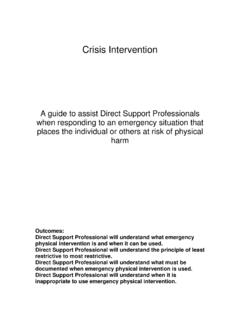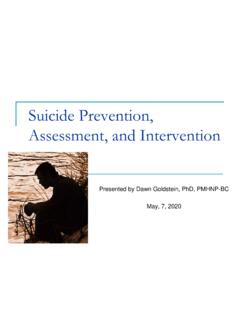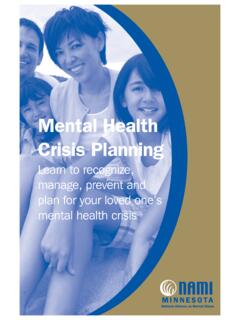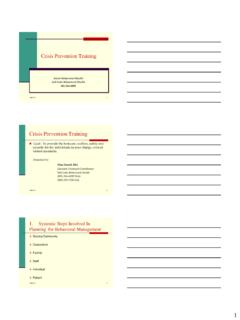Transcription of Crisis Intervention in Child Abuse and Neglect
1 Crisis Intervention in Child Abuse and Neglect Department of Health and Human Services Administration for Children and Families Administration on Children, Youth and Families National Center on Child Abuse and Neglect This manual was developed and produced by Circle Solutions, Inc., McLean, VA, under subcontract No. S-105-89-1730 with Westover Consultants, Inc. iii iii This page is intentionally left blank TABLE OF CONTENTS Page ATTRIBUTION .. vii PREFACE .. ix ACKNOWLEDGMENTS .. xi OVERVIEW OF THE MANUAL ..1 UNDERSTANDING Crisis ..3 Introduction ..3 Definition of Crisis ..3 Elements of Crises ..3 Stress-Producing Difficulties in Parents with Chronic Coping Timing of The Phases of Crisis ..6 Client Feelings During Crisis ..7 Psychological Effects of Crisis ..8 Disorganized Thinking ..8 Preoccupation With Insignificant Expression of Hostility and Emotional Threat to Identity ..9 10 Crisis Intervention GOALS AND STEPS .. 11 Introduction.
2 11 The Scope and Goals of Crisis Intervention .. 11 Six Goals of Crisis Treatment .. 11 A Nine-Step Crisis Intervention 12 Crisis Intervention Teams .. 13 13 iii Psychological First Aid .. 14 Rehabilitative Crisis 14 Overview of Teams Related to CPS .. 14 Specialized, Multidisciplinary Teams .. 15 Crisis as an Opportunity To Initiate Change .. 15 Crisis Intervention as a Planned 16 Presence Until Stress Is Reduced .. 17 17 Crisis Intervention ASSESSMENT .. 18 Introduction .. 18 Total Family Involvement .. 18 19 Making the Initial 19 Identifying the Precipitating Event .. 19 Observing Family Interactions and Conditions .. 20 Determining Family Assessing 21 Screening 22 Assessment of Other Special Issues .. 23 Suicide 23 Post-Traumatic Stress Disorder .. 23 Sex Offenders Ability To 24 When Assessment Indicates a Lack of Safety for 25 Crisis Intervention TREATMENT APPROACHES AND TECHNIQUES .. 26 Introduction .. 26 Eclectic Knowledge Ability To Focus Self and Approaches.
3 27 A Community Systems and Use of Community Resources Multiple Impact or Multimodal 28 Cognitive Behavioral 29 iv Task-Centered 29 The Family Treatment 30 The Eclectic Team 30 Techniques .. 31 Use of Humor .. 31 Generalization .. 31 Self-Disclosure and Storytelling .. 31 Setting 31 Instilling 32 Working Through 32 35 UNDERSTANDING SPECIAL FAMILY SITUATIONS .. 36 Introduction .. 36 Marital 36 Step-parenting 36 Unprepared for Parenthood .. 37 Substance Abuse .. 37 Spouse 38 Mental 39 Dual 40 40 TERMINATION AND FOLLOW-UP SERVICES .. 41 Introduction .. 41 Establish Limits From the 41 Teach Problem-Solving .. 41 Encourage Review 41 Establish a Plan for Evaluate Outcomes .. 42 v THE Crisis Intervention WORKER .. 43 Introduction .. 43 Vulnerability and Safety .. 43 Psychological State and 44 Preventing Burn-out .. 44 45 Training 46 46 FAMILY-CENTERED Crisis RESPONSE MODELS .. 47 Introduction.
4 47 Homebuilders .. 47 Families, Inc.. 48 Intensive Family Services (IFS).. 49 The Family Crisis Program .. 50 The Interagency Sexual Abuse 50 51 SUMMARY .. 52 When Crisis Anticipating Crises and Planning Proactively .. 52 NOTES .. 54 GLOSSARY OF TERMS .. 63 SELECTED BIBLIOGRAPHY .. 65 OTHER RESOURCES .. 67 vi ATTRIBUTION The Department of Health and Human Services acknowledges the contributions of Robert Borgman, Margaret Edmunds, and Robert A. MacDicken, who were the authors of Crisis Intervention : A Manual for Child Protection Workers, August 1979. iii This page is intentionally left blankPREFACE The Child Abuse Prevention and Treatment Act was signed into law in 1974. Since that time, the Federal Government has served as a catalyst to mobilize society s social service, mental health, medical, educational, legal, and law enforcement resources to address the challenges in the prevention and treatment of Child Abuse and Neglect .
5 In 1977, in one of its early efforts to achieve this goal, the National Center on Child Abuse and Neglect (NCCAN) developed 21 manuals (the User Manual Series) to provide guidance to professionals involved in the Child protection system and to enhance community collaboration and the quality of services provided to children and families. The manuals described each professional s roles and responsibilities in the prevention, identification, and treatment of Child maltreatment. Other manuals in the series addressed special topics, for example, adolescent Abuse and Neglect . Our understanding of the complex problems of Child Abuse and Neglect has increased dramatically since the user manuals were developed. This increased knowledge has improved our ability to intervene effectively in the lives of troubled families. Likewise, we have a better grasp of what we can do to prevent Child Abuse and Neglect from occurring. Further, our knowledge of the unique roles key professionals can play in Child protection has been more clearly defined, and a great deal has been learned about how to enhance coordination and collaboration of community agencies and professionals.
6 Finally, today we are facing new and more serious problems in families that maltreat their children. For example, there are significantly more families known to Child Protective Services (CPS) that are experiencing substance Abuse problems. Because our knowledge base has increased significantly and the state of the art of practice has improved considerably, NCCAN has updated the User Manual Series by revising many of the existing manuals and creating new manuals that address current innovations, concerns, and issues in the prevention and treatment of Child maltreatment. As a supplement to the manual Child Protective Services: A Guide for Caseworkers, this manual, Crisis Intervention in Child Abuse and Neglect , is intended for caseworkers who want to improve their assistance to children and families in Crisis . Other professionals in the field of Child protection, such as law enforcement officers, judges, educators, health care providers, and mental health counselors, may also find the information on Crisis Intervention helpful.
7 Iii This page is intentionally left blank ACKNOWLEDGMENTS Charles E. Gentry, , is executive director of Child and Family Services, a multiservice agency in middle east Tennessee. He has 32 years of experience in juvenile court, Child welfare, psychiatric hospital, outpatient psychiatric, family service, general hospital, and private practice settings. He has specialized in assessment and treatment of violence in families, as well as in writing and providing training across the United States. He is an adjunct professor at Carson Newman College. Recognition is given to Lori Hill, Darnell Bean, and other Child and Family Services staff for the typing and preparation of this manual. The following were members of the Advisory Panel for Contract No. HHS-105-89-1730: Peter Correia University of Oklahoma Tulsa, OK Howard Davidson American Bar Association Washington, DC Shirley Davis Child Development and Family Guidance Center St. Petersburg, FL Judee Filip National Resource Center Child Abuse and Neglect Denver, CO Sandra Hodge Department of Human Services Augusta, ME John Holton Greater Chicago Council for the National Committee for the Prevention of Child Abuse Chicago, IL Janet Hutchinson University of Pittsburgh Pittsburgh, PA Michael Nunno Family Life Development Center Ithaca, NY Marsha K.
8 Salus Chair User Manual Advisory Panel Alexandria, VA Nainan Thomas Child Welfare Division Prince George s County Department of Social Services Hyattsville, MD Anthony Urquiza University of California Sacramento, CA iii This page is intentionally left blankOVERVIEW OF THE MANUAL In the past, emergency room, law enforcement, and disaster relief teams developed distinct protocols for responding to family crises. The 1970 s and 1980 s brought about coordinated Intervention among community agencies and organizations responsible for responding to crises in cases of Child Abuse and Neglect . Growing concern about family violence stimulated the study and development of improved Crisis - Intervention approaches. There has been a growing misconception regarding the definition of Crisis Intervention . In Child Protective Services (CPS) practice, the terms Crisis Intervention and emergency services have sometimes been used interchangeably. This manual attempts to differentiate between emergency services and Crisis Intervention , further defining the territory and practice of Crisis Intervention with CPS cases.
9 Crisis Intervention and assessment are the first steps in strengthening clients problem-solving skills. Instead of studying the client s or family s background, the Crisis workers assess and focus on the unresolved problems that led to the Crisis . Client and Crisis worker energies are fully focused on the precipitating events and the problem-solving process. A solution-focused paradigm, which addresses the clients concerns, can generate cooperation and quicker solutions to the Crisis . Problem-solving or task-centered approaches can prevent unclear, unfocused Crisis Intervention . By helping clients think about what has worked for them in the past and what might be more effective now, planning and action steps are put in place for resolving the family s problems. Crisis Intervention emphasizes that clients have the strengths to resolve crises. Crisis workers help clients discover and use their potential. The Crisis workers positive attitude about the clients abilities has a powerful suggestive impact on clients.
10 Therefore, crises present a unique opportunity for change in the lives of the parents and children involved. During a period of intense Crisis , when usual methods of coping fail, families become more open to new problem-solving approaches. Moreover, during this period of imbalance, they are willing to consider that change for the better is possible. This manual, while addressing principles and techniques of Crisis Intervention with Child Abuse or Neglect cases, recognizes the interrelatedness of all forms of intrafamilial and societal violence. Any situation involving suspected Child Abuse or Neglect is a Crisis . Crisis Intervention refers to the approach or techniques used by those individuals or teams who respond to the Crisis . Crisis Intervention is a planned response that requires specialized roles, training, and supervision. This section has presented a brief overview of Crisis . A definition of Crisis , the elements and phases of crises, client feelings, and the psychological effects of crises are the focus of the next section, Understanding Crisis .


















